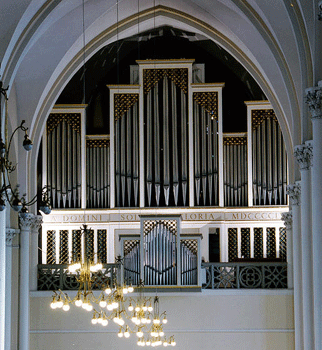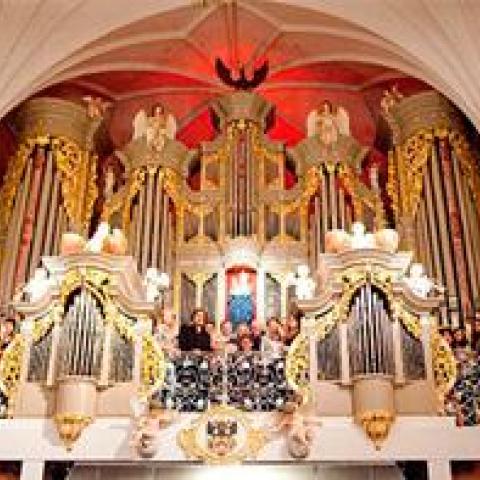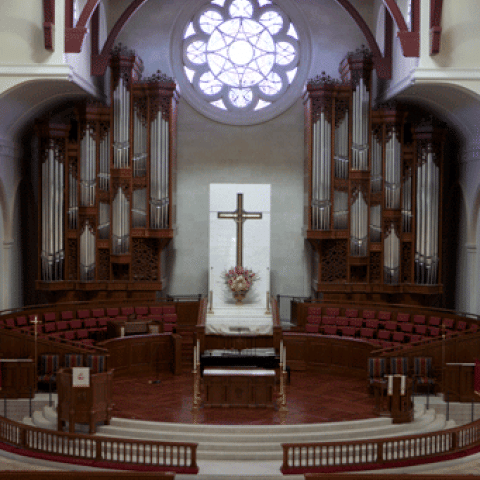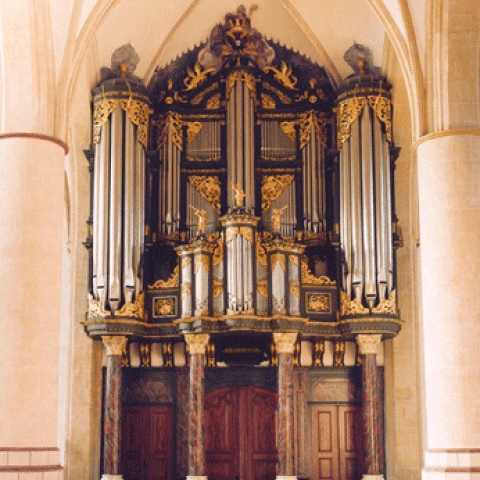In nineteenth-century Russia, secular and sacred music had very little to do with each other, due to a separation in large part imposed by the Orthodox Church. Musicians of the West are familiar with this divorce of musical spheres, having endured a similar division in musical culture from the Middle Ages through the sixteenth century. However, there is a clear difference between the two experiences of division; this can be seen in the role of the organ.
In Europe, the organ and its repertoire developed mainly in the sacred realm, playing an integral role in church services both in the Medieval Roman Catholic Church as well as in the multiple denominations born in the Protestant Reformation. But in Russia, instruments were not allowed to be a part of Orthodox church services. According to the church, the voice was the only instrument necessary and worthy of use in liturgical settings.1 While the organ was used at times in church services of minor outlying denominations, there was most definitely a dearth of liturgical organ music compared to the concurrently flourishing sacred traditions of western countries. Some may view this as a deficiency, but in another sense, the Russian repertoire for the organ in the nineteenth century provides a unique secular perspective on general musical trends. It is fascinating to consider the connections among the European organ traditions as specifically represented in music from the nineteenth century.
The oldest surviving record of pipe organs in Russia can be seen in the fresco of skomorokhi at Saint Sofia Cathedral in Kiev,2 which dates to the eleventh century. The church outlawed these troubador-like figures, deeming them disciples of the devil.3 Regardless of the Orthodox Church’s antagonism towards amusement of any kind (even private musical activity in the home), the skomorokhi were in very high demand by various wealthy aristocrats and merchants.
Through the centuries, the organ gained ground outside of the church on its own merits as an instrument suitable for court entertainment, especially in the fifteenth to eighteenth centuries. Organ builders from Poland and the Netherlands were invited to establish firms; these as well as some minor Russian builders functioned, for the most part, on the whim of the tsar.
In the nineteenth century, the instrument had so grown in social status that it attracted the notable personage Prince Vladimir Odoyevsky (1804–1869) to become the first documented composer of organ music in Russia. He also commissioned a singular instrument for his home from the Saint Petersburg builder Georg Mälzel. It was modeled after Baroque organs of North Germany and nicknamed “Sebastianon.”4 While the instrument has not survived, its specifications are provided here:
Manual I
8′ Dulciana
8′ Gedackt
2′ Octavina
Sesquialter
Manual II
8′ Flauto traverso
4′ Fugara
8′ Melodicon
Pedal
16′ Subbass
Melody coupler
Pedal coupler
The 8′ Flauto traverso stop had a so-called “espressivo” effect, i.e., its volume varied with the pressure on the key.
Odoyevsky often held musical gatherings where musicians such as Mikhail Glinka improvised on the instrument. The prince himself was known for occasionally improvising fugues based on themes from Russian folksongs. In addition to an active performing life, he is also reputed to be the first Russian musicologist,5 having copied out music from the Italian Renaissance and organ works of Johann Sebastian Bach, collected Russian folksongs, and published articles discussing musical trends of the past and of his time.
In Odoyevsky’s organ pieces, there are characteristics that reflect some aspects in the Russian ethos of music making in the nineteenth century, namely a sensitivity to color (in registration) and a disregard for Western traditions of composition. For instance, in measures 4–7 of Prayer Without Words, opus 73, number 2, the player (or registrant) is required to add and take away the Nazard every two beats, a purely coloristic effect.
In a later portion of the same piece, Odoyevsky uses octaves in a way that would baffle any western organist. Since he was in possession of stops at 8′ and 4′ pitches as well as manual and pedal couplers, it would at first seem that the doubling in measures 13–21 (Example 1) is entirely unnecessary.6 Yet, it is possible that the melodic octaves in measure 13 might be inspired by the znamenny chant, which developed from the ancient Byzantine tradition of the Eastern Orthodox Church. Yet the doubling in measures 14–15 is inconsistent with that thought and seems to come more from a pianistic style of composition.
There are other subtle instances of Western influence here. In the title Prayer without Words, there is an echo of Felix Mendelssohn’s character pieces Songs without Words for the piano. And in the simple lyricism of this piece, one sees the influence of Irish composer John Field, the inventor of the nocturne, who taught and inspired Odoyevsky, Glinka, and Frederic Chopin.
In 1833, Mikhail Glinka studied composition with German composer Siegfried Dehn. Glinka wrote (of Dehn), “He . . . not only put my knowledge in order, but also my ideas on art in general.”7 Out of this productive period came the opus 93 fugues for the organ: E-flat major, A minor, and D major. The influence of Germanic contrapuntal training is obvious in the treatment of the subjects, with use of parallel minor key, inversion, and stretto. Resisting imitation, Glinka did not write a Baroque fugue. The expressive leaps of the A minor fugue subject (Example 2),8 the motivic development of the codas, and the dynamic markings all point to a Romantic sensibility particular to Glinka.
It is interesting to consider this work in light of what Richard Taruskin has written about Glinka:9
What makes Glinka a founding father [of Russian music] has mainly to do not with his being the “formulator of Russian musical language,” whatever that may mean, but rather with the fact that he was the first Russian composer to achieve world stature. In short, with Glinka, Russian music did not depart from Europe but quite opposite—it joined Europe.
While the organ repertoire expanded, so did interest in the instrument; this can be seen in the establishment of organ departments of the first conservatories in the country. The Saint Petersburg (founded 1862) and Moscow (founded 1866) conservatories, headed up by the Rubinstein brothers, included organ study in their course offerings. Remaining consistent with the emphasis of their curriculum, the professors hired hailed from Europe. The first organ teacher appointed in Saint Petersburg was Heinrich Still, a German organist who studied at the Leipzig Conservatory. Jacques Handschin, another professor of organ in Saint Petersburg, was of Swiss descent, but born in Russia. Having studied with organists Charles-Marie Widor, Max Reger, and Karl Straube, Handschin provided a direct link to some of the greatest luminaries of the European organ world. It is interesting to note that Pyotr Tchaikovsky was one of the first students in the organ classes at the Saint Petersburg Conservatory, graduating with a minor in organ studies.10
Despite its restricted use in the Orthodox Church, it is evident that in nineteenth-century Russia, the organ was thriving as a salon instrument, piquing the interest of composers and gaining respect in the academic field. Yet another aspect of the Russian organ world is its concert life. Franz Liszt’s recital of 1843, performed at the church of Saints Peter and Paul in Moscow, astounded and impressed. The frequent programs of music by Bach, presented by Johann Wilhelm Hassler in the early part of the nineteenth century, had an unprecedented cultural as well as academic influence. Widor himself gave the dedication recital in 1899 for the Cavaillé-Coll organ in Moscow.11
Another development of the organ world reflective of the Russian musical scene at large can be seen in the instruments acquired by the conservatories. There was an organ built by Eberhard Walcker at Saint Petersburg and two Ladegast organs in Moscow. But the grandest statement of all is found in the last opus of Aristide Cavaillé-Coll, the world-renowned organ innovator, which was installed in Bolshoi Hall at the Moscow Conservatory in 1899. This symphonic instrument undoubtedly had a huge influence in the performance and compositional direction of organ works in Russia. Its specifications are found here.12
Grand Orgue (Manual I, C–g3)
16′ Montre
16′ Bourdon
8′ Montre
8′ Flûte harmonique
8′ Violoncelle
8′ Bourdon
4′ Prestant
2-2⁄3′ Quinte
2′ Doublette
Plein jeu V
Cornet V (c–g3)
16′ Bombarde
8′ Trompette
4′ Clairon
Positif (Manual II, C–g3)
16′ Quintaton
8′ Salicional
8′ Flûte harmonique
8′ Cor de nuit
4′ Principal
4′ Flûte douce
2′ Doublette
Cornet V (c–g3)
8′ Trompette
8′ Cromorne
8′ Basson
Plein jeu IV
Récit (Manual III, C–g3)
16′ Bourdon
8′ Diapason
8′ Flûte traversière
8′ Viole de Gambe
8′ Voix-céleste
4′ Flûte octaviante
2′ Octavin
Plein jeu IV
16′ Basson
8′ Trompette
8′ Basson et Hautbois
4′ Clairon harmonique
Tremblant
En chamade (Manual III)
8′ Trompette
4′ Clairon
Pédale (C–g1)
32′ Flûte
16′ Contrebasse
16′ Soubasse
8′ Flûte
8′ Bourdon
4′ Flûte
Plein jeu IV
16′ Bombarde
8′ Trompette
4′ Clairon
Pédales de combinaison
Tirasse du Grand Orgue (I/P)
Tirasse du Positiv (II/P)
Tirasse du Récit (III/P)
Anches Pédale
Anches Chamade
Anches Grand Orgue
Anches Positif
Anches Récit
Octaves grave Grand Orgue
Octaves grave Positif
Octaves grave Récit
Expression Positif
Expression Récit
Grand Orgue sur Machine
Positif au Grand Orgue
Récit au Grand Orgue
Récit au Positif
Octaves grave du Récit au Grand Orgue
Sonette
dans Buffet d’orgue:
8′ Flûte, 8′ Violoncelle (Pédale), 16′ Montre, 8′ Montre, 8′ Flûte harmonique, 8′ Violoncelle, 4′ Prestant (Grand Orgue)
Mechanical key action (with Barker lever)
Mechanical stop action
An organ so fully equipped with a French reed chorus as well as string stops on every division is uniquely suited to perform symphonic repertoire. Unsurprisingly, there was already a significant representation of pieces inspired by the organ symphonies of French composers like Louis Vierne and Charles-Marie Widor. One fine example is the Prelude and Fugue in D Minor, opus 98,13 by Alexander Glazunov, which can be played convincingly only on an organ such as this (Example 3).
Here one encounters a far more technically advanced composition than either the character piece or fugue mentioned above. In the first place, there is double pedal, which poses a certain physical challenge for the performer. There is also a complex registration scheme: symphonic in nature, with flutes and strings working as separate ensembles, and contrasting dynamics achieved by means of adding octaves above and below 8′ pitch. Following the fugue, in measure 196 comes the classic French symphonic organ sound of full foundation stops (strings, flutes, principals) along with mixtures and reeds (labeled anches). Yet he does not stop there, as he adds even more 8′ reeds in measure 200,14 and 4′ reeds for the final chord (Example 4).
However technically advanced, there is also a marked difference in character between this and the works of composers such as Glinka, Odoyevsky, and César Cui. These all belonged to the generation of “The Mighty Five,” a group centered around the charismatic Mili Balakirev, who stood staunchly against the Germanic tradition of music making fostered by the conservatories. Richard Leonard says of Balakirev:15
[His] teaching methods, his disdain of textbook instruction in harmony and counterpoint, his insistence that learning should come instead from the study of great works, and above all his despotic handling of his pupils’ efforts, have all been the subject of endless debate.
This debate polarized the community and the musical conversation in Russia for much of the nineteenth century. While Balakirev’s free-spirited group was highly idealized, almost utopian in its philosophy, it did have one mark against them. They did not include organ study in their “Free School,” set up in opposition to the academic conservatism of the Moscow and Saint Petersburg schools. In the end, the Mighty Five gave way to a new group known as the Belyayev Circle, which aligned itself with the more academic aspirations of the conservatories. While the scholastic emphasis brought the advantage of consistent technical growth through systematic study, Leonard points out the weaknesses of this group:16
Inevitably, the strong academic influence brings with it a prevailing conservatism . . . . They lack the pioneering spirit, the urge towards enterprise, which had set in motion Glinka, Balakirev . . . . They are competent but unadventurous.
One sees this contrast exemplified in the music of composers César Cui and Sergey Liapunov. César Cui was part of Balakirev’s Circle, mainly remembered now for his articles written in various musical journals. After attending a concert where music of the Belyayev Circle was featured, Cui wrote an article entitled “Fathers and Sons” (the Mighty Five being the fathers, and Belyayev’s Circle the sons). In that article, he calls on the younger generation to “abandon this false path” and to “absorb the idea that the purpose of music is not to astound but to attract and captivate, that everything great is usually simple[;] that one cannot make oneself original by one’s own wish.”17
In Cui’s delicate and graceful salon piece, Prelude in G Minor,18 there is much influence from folksong, especially in measures 17–30 (Example 5), where the theme takes on a more simple and earthy quality than the opening section. The pianistic writing, seen especially in the arpeggiation of measures 16–20, somewhat detracts from its overall effectiveness. Even so, there is a certain warmth and personality to this small piece that lends a value all its own.
However, Cui’s prelude lacks motivic development and harmonic complexity in comparison to Liapunoy’s Prélude Pastoral, opus 54. Structured in variation form, this piece is much more advanced from a technical standpoint. Here we see the main thrust of the difference between the Balakirev and Belyayev groups. Although Liapunoy has a technical familiarity in writing for the organ, his music lacks the inspiration of even a small character piece by Cui, who is reputed to be one of the weakest composers of the Mighty Five.19
Take measures 126–135 (Example 6),20 for instance. The whole piece centers around this moment. In the thirty bars prior, the registration and rhythmic pulse have all been building towards this point. In typical French fashion, the Grand jeux (reed chorus) is indicated here, and yet (in the author’s opinion) there is something supremely unsatisfying about this climax. The simplistic sequence, followed by stepwise motion and ending with octave arpeggiation does not seem worthy of the technical mastery of this piece or of the musical suspense that anticipated this turning point. The piece is practically finished at this point, though there are a few more variations that spin out the theme and gradually diminuendo towards a gentle close.
So, there is organ music that represents a synthesis of style between the technical forms and tools used in Western traditions and the various aims of Russian musicians throughout the nineteenth century. Perhaps the most interesting examples of this integration can be seen in the pieces that expressly intend to convey a Russian character. For instance, Reinhold Glière’s three-voice Fugue on a Russian Christmas Song21 does not seek to emulate either the French symphonic style or the Germanic tendencies of fugue. He uses the form merely to develop and express the theme to its utmost. His aim being such, the result is a piece entirely determined by the syncopated rhythmic profile and folk-like character of the subject (Example 7).
Although there seems to be much disparity in approach between the passionate idealism of Balakirev’s school of thought encouraged by Glinka and the technical and historical prowess of the Belyayev Circle, both generations eventually give way to a new method of composing, which incorporates emphases of both camps. Sergey Taneyev did his utmost to articulate this new vision when he wrote:22
The task of every Russian composer consists in furthering the creation of national music. The history of western music gives us the answer as to what should be done to attain this: apply to the Russian song the workings of the mind that were applied to the song of western nations, and we will have our own national music. Begin with elementary contrapuntal forms, pass to more complex ones, elaborate the form of the Russian fugue . . . . The Europeans took centuries to get there, we need far less. We know the way, the goal, we can profit by their experience.
From the Choral-Varié of Sergey Taneyev, to Glazunov’s Fantasy, opus 110, and finally into twentieth-century organ works by Rachmaninov and Khatchaturian, one sees an even more pronounced integration of Western technique and form and the Russian spirit—a realization of Taneyev’s vision.
Notes
1. “An Overview of Russian Organ Music,” American Guild of Organists 2014 National Convention, Boston, Massachusetts, last modified September 2013: http://www.agoboston2014.org/wp-content/uploads/2013/09/Russian-Organ-Music-Katya-Gotsdiner-McMahan.pdf.
2. “Mosaics and Frescoes of St. Sofia Cathedral in Kiev.” Sofia Cathedral website, accessed May 8, 2018: http://sofiyskiy-sobor.polnaya.info/en/sofia_cathedral_mosaics_and_frescoes.shtml.
3. Victor Seroff, The Mighty Five: The Cradle of Russian National Music (New York: Allen, Towne & Heath, Inc., 1948), 5.
4. Victoria Adamenko. “Russia,” in The Organ: An Encyclopedia, ed. Douglas Bush and Richard Kassel (New York: Taylor & Francis Group, LLC, 2006), 479.
5. “Prince Vladimir Fyodorovich Odoyevsky (1803–1869) and Music.” RISM, last modified September 14, 2017, http://www.rism.info/home/newsdetails/select/rism_a_z/article/64/prince-vladimir-fyodorovich-odoyevsky-1803-1869-and-music.html.
6. Alexander Fiseisky, ed., Organ Music in Russia, v. 1 (Basel: Bärenreiter-Verlag Karl Vötterle GmbH & Co. KG, Kassel, 1997), 10.
7. Richard Leonard, A History of Russian Music (New York: The Macmillan Company, 1957), 43.
8. Fiseisky, Organ Music in Russia, 4.
9. Richard Taruskin, On Russian Music, (California: University of California Press, 2009), 29.
10. Adamenko, The Organ: An Encyclopedia, 479.
11. Fiseisky, Organ Music in Russia, XXII.
12. Fiseisky, Organ Music in Russia, XVI.
13. Fiseisky, Organ Music in Russia, 40.
14. Fiseisky, Organ Music in Russia, 46.
15. Leonard, A History of Russian Music, 69.
16. Leonard, A History of Russian Music, 202.
17. César Cui, “The Results of the Russian Symphony Concerts: Fathers and Sons,” in Russians on Russian Music, 1880–1917, ed. Stuart Campbell (Cambridge: Cambridge University Press, 2003), 137.
18. Fiseisky, Organ Music in Russia, 2.
19. Leonard, A History of Russian Music, 66.
20. Fiseisky, Organ Music in Russia, 12.
21. “Les Maitres Contemporains de L’orgue,” IMSLP, last modified March 26, 2012, http://ks.imslp.info/files/imglnks/usimg/c/cd/IMSLP193273-PMLP332253-Glière,_Reinhlod,_Fugue_sur_un_thème_de_Noel_russe._EdJoubert,_Sibl.FE.pdf.
22. Alfred Swan, Russian Music And Its Sources in Chant and Folk-Song (New York: W. W. Norton & Company, Inc., 1973), 132.
Bibliography
Adamenko, Victoria. “Russia,” in The Organ: An Encyclopedia, edited by Douglas Bush and Richard Kassel, 480. New York: Taylor & Francis Group, LLC, 2006.
American Guild of Organists 2014 National Convention, Boston, Massachusetts. “An Overview of Russian Organ Music.” Accessed May 8, 2018. http://www.agoboston2014.org/wp-content/uploads/2013/09/Russian-Organ-Music-Katya-Gotsdiner-McMahan.pdf.
Cui, César. “The Results of the Russian Symphony Concerts: Fathers and Sons.” In Russians on Russian Music, 1880–1917, edited by Stuart Campbell, 137. Cambridge: Cambridge University Press, 2003.
Fiseisky, Alexander, ed. Organ Music in Russia, vols. 1–3. Basel: Bärenreiter-Verlag Karl Vötterle GmbH & Co. KG, Kassel, 1997.
Leonard, Richard. A History of Russian Music. New York: The Macmillan Company, 1957.
Petrucci Music Library. Les Maitres Contemporains de L’orgue. Accessed May 9, 2018. http://ks.imslp.info/files/imglnks/usimg/
c/cd/IMSLP193273-PMLP332253-Glière,_Reinhlod,_Fugue_sur_un_thème_de_Noel_russe._EdJoubert,_Sibl.FE.pdf.
Répertoire International des Sources Musicales. “Prince Vladimir Fyodorovich Odoyevsky (1803–1869) and Music.” Accessed May 8, 2018. http://www.rism.info/home/newsdetails/select/rism_a_z/article/64/prince-vladimir-fyodorovich-odoyevsky-1803-1869-and-music.html.
Ritzarev, Maria. Eighteenth Century Russian Music. Burlington: Ashgate Publishing Company, 2006.
Seroff, Victor. The Mighty Five: The Cradle of Russian National Music. New York: Allen, Towne & Heath, Inc., 1948.
Swan, Alfred. Russian Music And Its Sources in Chant and Folk-Song. New York: W. W. Norton & Company, Inc., 1973.
Taruskin, Richard. On Russian Music. California: University of California Press, 2009.







